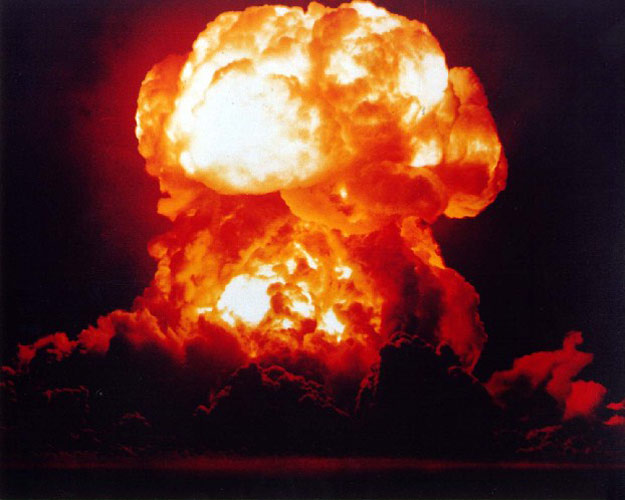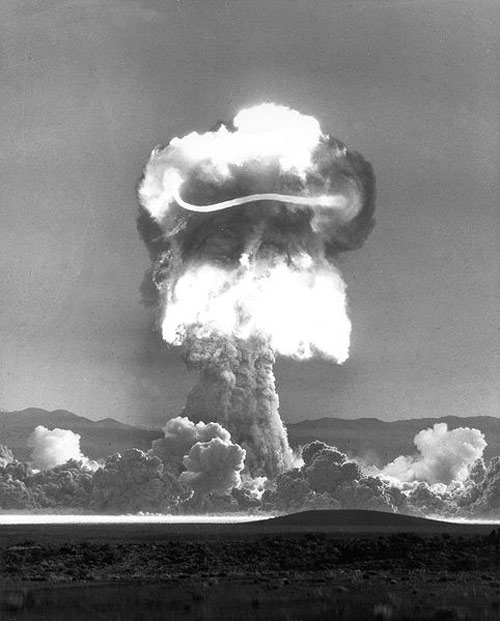Atomic Bomb Shot Out of a Cannon
Page 2 of 2
The Underground Test
The underground tests, some as deep as 5,000 feet, vaporized a huge chamber filled with radioactive rubble. The site remains one of the most contaminated places in the U.S, with some of the water supply affected for tens of thousands of years. In spite of 536 demonstrations involving over 37,000 people, causing over 15,000 arrests, the tests continued. Protests and efforts are underway to stop huge piles of highly radioactive waste adjacent to the test site. Spreading deadly radiation continues with apparently no way to stop it.
Medical Report
A 1979 study in the New England Journal of Medicine concluded that a significant excess of leukemia deaths occurred in children up to 14 years of age living in Utah between 1959 and 1967. This excess was concentrated in children born between 51 and 58, and was most pronounced in those residing in counties receiving high fallout from the nuclear blasts at the Nevada Test Site.

Smoky Operation Plumbbob 57kt
Medical Lawsuits
In 1982, a lawsuit by nearly 1,200 people accused the U.S. Government of negligence in the atomic or nuclear testing at the Nevada Test Site in the 1950s, which they said had caused leukemia and other forms of cancer. Dr. Karl Z. Morgan testified that radiation protection measures in the tests were substandard.

Storax Sedan 1962 Yucca Flat Nevada
U.S. Admits to Radiation Accusations
In a report by the National Cancer Institute, released in 1997, it was determined that ninety atmospheric tests at the Nevada Test Site deposited high levels of radioactive iodine-135 across a large portion of the contiguous U.S., especially in the years 1952, 1953, 1955 and 1957- doses large enough, they determined, to produce 10,000 to 75,000 cases of thyroid cancer. The Radiation Exposure Compensation Act of 1990 allowed for people living downwind of the test site for at least two years , particularly in Nevada, Arizona, or Utah counties between. 21 Jan. 1951 to 31 July 1962, and suffering from certain cancers or other serious illnesses deemed to be caused by fallout exposure to receive compensation of $50,000. By Jan. 2006 over 10,000 claims had been approved, and around 3,000 denied, for a total of $525 million in compensation to the “downwinders.” Additionally , the Energy Employees Occupational Illness Compensation Program Act of 2000 provides compensation and medical benefits for nuclear weapons workers who may have developed certain work related illnesses: uranium mines, mill workers, and ore transporters are also eligible for $100,000 compensation payment, and $75,000 fixed payment amount for workers who were participants in the above-ground nuclear weapons tests.

Priscilla 37kt Plumbbob Series
RB-29 Participation in Atomic Test at Nevada Test Site
RB-29 "Tiger LiL" and it's crew had flown their 50 combat missions over Korea, and the crew returned to the U.S. Tiger Lil was left behind at Yokota AFB in Japan and was later shot down by two Russian Mig-15s. Upon arrival in the U.S. our crew was stationed at Fairchild AFB in Spokane, Washington. Very shortly after being assigned to Fairchild we were ordered to remove the two gun-sights in the side blisters, and all 12 machine guns from our newly received RB-29. We were called in a room where a base Colonel advised us we would be going on temporary duty for 10 days. He never said where we were going or why the strange changes to our aircraft. We were warned that from that moment on we were not to discuss this with anyone including other crews in our Squadron. Our entire crew already had a secret clearance, I was the only one with a “top” secret, from my work in Korea. We were told that after take off we would be advised by the Aircraft Commander exactly where we were going, and why. After takeoff we were told we were on our way to California to take part in the atomic blasts series at the Nevada Test Site. We landed at Edwards AFB where we were given full particulars as to what our mission was. The Nevada Test Sight was engaged in a large number of nuclear bomb explosions, and that we would be photographing two of them from high altitude. I immediately felt that they had selected the wrong type of aircraft, maybe an RB-45 would have been better. I thought it was unusual for any aircraft to be flying around an actual bomb blast. As a dedicated airman I of course kept any thoughts to myself. We were once again warned about security during our stay there, and also after returning to our home base. Another Lt. Col. Entered and announced he would be in charge of the entire project. I later found out "from him" that he had no experience with the B-29, in fact had never flown in one. The purpose of our mission of course was to collect a mass of photographic information and he was also not familiar with our camera equipment. This was a once in a lifetime job for our crew, and we were determined to perform at our best.

Nevada Atomic Cannon Bomb
I was a graduate of the one year photography course in Denver at Lowry AFB, also attended gunnery school, with a job identification of Aerial Photo Gunner. I was also a pilot, though not Air force trained. My 50 missions over Korea, with some flights over China And Russia, plus many commendations I believed made me well qualified for this mission. Our plane was jammed with aerial photographic equipment, much of it movie cameras which we normally did not carry in combat. After double checking all equipment and making certain everything was working properly, we were ready to go. We took off and headed for Yucca Flat, the Nevada Test Site. Everything was ready just waiting for the blast, when we were informed due to some malfunction the test was postponed. Time for the second try occurred the next day and we were off again. We were supposed to climb to maximum altitude when not surprisingly number three engine began overheating. This prevented us making it to even 30,000 feet. The pilot positioned the plane where ground control ordered, and then came the countdown.
The explosion was reported to be a 15kt blast which was the same size as Little Boy over Hiroshima. I had noticed there was a huge circle on the ground, and around it appeared to be cars, trucks, military equipment and apparently specially constructed buildings. The bomb was positioned on a huge tower. Then came the five, four, three ,two, one. The bomb exploded exactly as planned, and in my wildest imagination did I expect such an enormous explosion. It appeared that upon explosion the bomb spread out on the ground and sucked up all the perimeter items placed there. It was a magnificent sight I will never forget. We immediately felt the shock wave from the bomb, which was pretty substantial, and moments later the shock wave from the ground. The one from the ground was created when the shock wave from the bomb hit the ground and bounced back. All cameras were grinding away without any malfunction. The mushroom cloud rose quickly to thousands of feet higher than our position. Our results were reported to be exactly what was needed.
Before leaving to return to Fairchild AFB we were again warned that we were under orders not to even mention our mission. After 58 years I guess it’s O.K. to talk about it. Each crewmember wore a radiation monitor which determined the presence of any contamination. The one thing that stays in the back of my mind is that this was a comparatively small explosion compared to the Hydrogen bomb. It is indeed frightening to think that in a few seconds our entire universe could be wiped out. What a horrible thought.
Research By Website Historian Wayland Mayo


